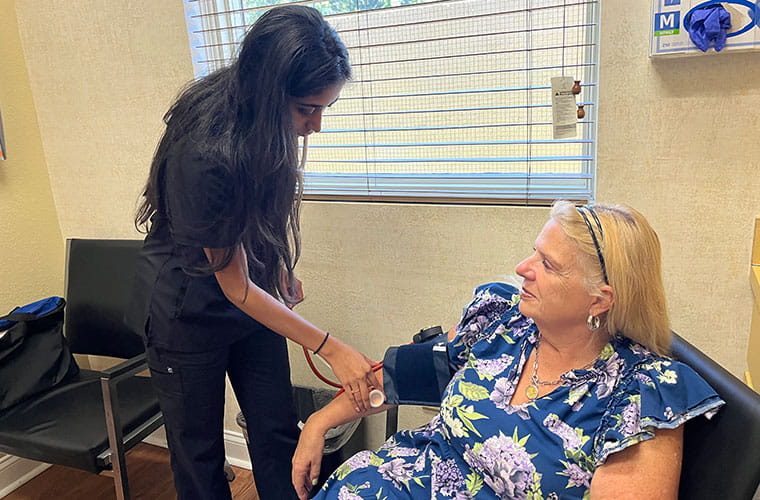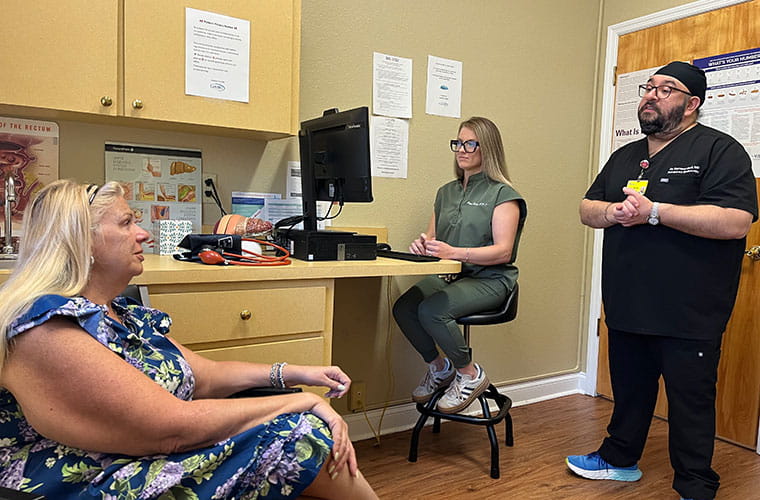Third Space Endoscopy Procedures Bring Life-Changing Outcomes for BayCare Patients

When she moved to Florida seven years ago, Sunny Wilson was looking for a change. A widow with two adult daughters, she decided to leave her home state of Texas behind for the sandy beaches of Pinellas County.
But one thing came with her: gastric issues that had plagued her for most of her life. Fortunately for Wilson, she found medical experts at BayCare’s St. Anthony’s Hospital in St. Petersburg and benefitted from the hospital’s commitment to offering expertise and innovative care – including a procedure called third space endoscopy.
Doctors in Texas were unable to pinpoint a cause for Wilson’s gastrointestinal (GI) issues. As a building materials salesperson, she often entertained customers over dinner, but frequent illness after eating made her hesitant to go out. Over time, her condition continued to worsen. Meanwhile, St. Anthony’s Hospital was preparing to offer third space endoscopy to treat many common GI illnesses.
Through third space endoscopy, interventional endoscopists perform complex procedures inside the wall of the GI tract. While such procedures once required open or laparoscopic surgery, minimally invasive third space endoscopy is now an option to treat precancerous and cancerous lesions, swallowing disorders, gastroparesis and Zenker’s diverticulum, among other GI conditions.
Although third space endoscopy is a relatively new advancement, introduced within the last decade, procedures in the first and second spaces have a longer history. First space procedures, performed inside the digestive tract, date back to the 1860s, while second space procedures, involving body cavities outside the GI tract, emerged in the early 2000s.
After a series of tests, a gastric emptying study uncovered Wilson’s GI problem: Only a small portion of her food was making its way from her stomach into the small intestine. She was diagnosed with gastroparesis, or paralysis of the stomach.
In late February, Wilson underwent a third space endoscopy procedure through her mouth called gastric per-oral endoscopic myotomy (G-POEM). The procedure cuts the pylorus muscle at the outlet of the stomach, allowing food to empty more easily into the small intestine.

In addition to the G-POEM procedure, third space endoscopy also has other specific procedures:
- Esophageal Per-oral Endoscopic Myotomy (POEM): Used to treat swallowing disorders caused by muscle dysfunction in the esophagus.
- Endoscopic Submucosal Dissection (ESD): Used to remove precancerous lesions or early-stage cancers from the GI lining. This technique allows for removal of larger or deeper sections of tissue with precision, often preventing the need for surgery if the cancer is detected early.
- Zenker’s Diverticulotomy: Used to treat Zenker’s diverticulum, a pouch that forms in the upper esophagus and causes difficulty swallowing, regurgitation and sometimes aspiration (food entering the airway).
“Third space endoscopy offers an exciting, less invasive alternative to traditional surgery, with comparable or superior outcomes for a range of GI conditions,” said Gurneet Bedi, MD, section chief of gastroenterology and advanced endoscopy for St. Anthony’s Hospital. “It provides patients with faster recovery times and fewer complications.”
As evidence of BayCare and St. Anthony’s continuous commitment to innovation, the hospital is currently testing a piece of equipment, the ERBE jet, which acts as a sort of pressure washer to create the third space, said Jessica Winans, endoscopy nurse manager at St. Anthony’s Hospital. Prior to the use of the new technology, the third space was created with knives and forceps.
“The G-POEM procedure has been life-changing,” Wilson said. “The gastroparesis was debilitating. It caused social problems. I love to travel but couldn’t for fear that I wouldn’t be able to eat.
“I can now function as a normal person,” she proclaimed. “It gave me back my freedom.”
Learn more: BayCare’s surgical services
